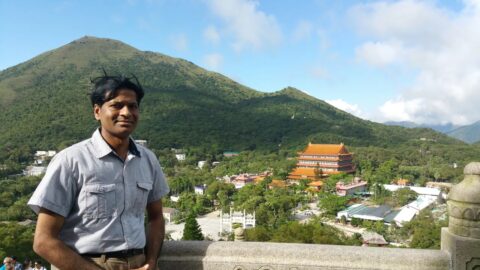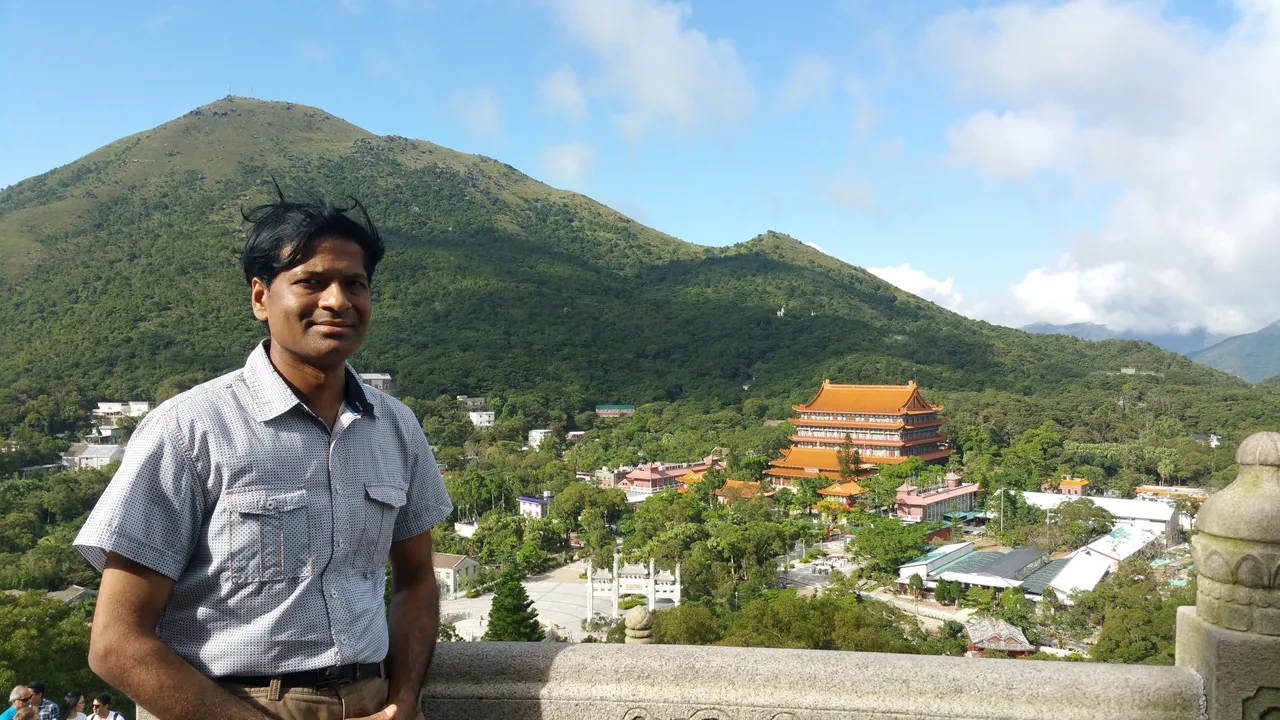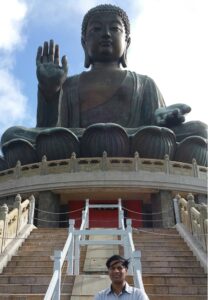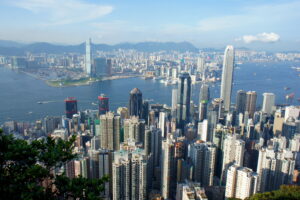| |
|
Di Tan (Altar of Earth)
- Di Tan (Altar of Earth) is situated at the foot of Mount Muk Yue
- It is connected with Tian Tan (Altar of Heaven) with a flight of wide stone steps – the 260 steps taking you to the Big Buddha.
- Altar of Earth is where the monastery holds it major functions and ceremonies.
- Standing in its middle is the Wall of Echoes.
|
| 2 |
|
Tian Tan (Altar of Heaven) Big Buddha
- The Altar of Heaven Big Buddha is the largest outdoor bronze statue of sitting Buddha in the world
- The Buddha statue is made with 202 bronze pieces = 160 pieces for the body, 36 for the lotus flowers, and 6 for the clouds.
- Together with the lotus seat, the statue stands at 26.4m.
- Measured with the three-level base platform, the edifice towers at 34m, weighing 250 tonnes.
- The three-level design of the base platform is modelled on the marble stone base of the Hall of Prayer for Good Harvests at the Altar of Heaven in Beijing.
- It had taken 12 years for the construction of this Buddha statue of grandeur and solemnity that symbolizes a steady and prosperous Hong Kong, a great and contented China and a world at peace
|
| 3 |
|
Mountain Gate and the Literary Couplet
- At the side of the Altar of Earth is a white antiquated torii carved out of a large rock
- It was erected when the monastery was first established in front of the old Main Shrine Hall
- It was placed here after several relocations.
|
| 4 |
|
Bauhinia Park
- Behind the Mountain Gate lies the Bauhinia Park, opening up to the Hall of Bodhisattva Skanda.
- The park was established, upon the return of Hong Kong to China’s sovereignty, for the display of bauhinia, the flower of the Hong Kong SAR.
- A shaded path cutting through the centre of the park leads to the entrance of the monastery
|
| 5 |
|
Hall of Bodhisattva Skanda
- Past the Mountain Gate, a passage way on the left leads to the Hall of Bodhisattva Skanda, the main entrance of the monastery.
|
| 6 |
|
Scripture Library
- The Scripture Library was originally located at the back of the Main Shrine Hall of the Buddha.
- It is now temporarily housed on the upper floor of the Hall of Bodhisattva Skanda to make way for the construction of the Grand Hall of Ten Thousand Buddhas.
- The Scripture Library houses a precious collection of Buddhist sutras and canons, including a set of Chinese Tripitaka, the Qianlong Tripitaka, consisting of 7,173 volumes, produced in Qing Dynasty during the time 1735 AD to 1738 AD.
- It was presented by the Buddhist Association of China, a much treasured version, being the last official wood-block print published in China.
|
| 7 |
|
Guest Hall
- The Guest Hall is where travelling monks from all directions and visiting guests are received and registered
|
| 8 |
|
Reception Pavilion (Under construction)
- This is the venue where honourable guests of major functions and ceremonies are received.
- In other times, visitors may take a rest or a lull here, removed from the worldly bustle, relieved in an aura of religious tranquillity and serenity, enjoying a moment of inner peace and joy.
|
| 9 |
|
Main Shrine Hall of Buddha
-
- The Main Shrine Hall of Buddha was built in 1970
- The hall enshrines Buddhas of Three Worlds
- Buddha Sakyamuni of our World in the middle
- Buddha Bhaisajyaguru (Master of Healing) on the left
- Buddha Amitabha (Buddha of Unlimited Light and Life Spans) on the right.
- Buddha Sakyamuni is attended by two acolytes
- The aged one being Mahakasyapa (the “most austere” amongst Buddha’s ten disciples)
- The younger one Ananda (Ananda was the “most learned”, the most well-versed with Buddha’s teachings)
|
| 10 |
|
Hall of Arhats
- At the lower level of the Main Shrine Hall of Buddha is the Hall of Arhats which also enshrines
- Bodhisattva Avalokitesvara
- Bodhisattva Manjusri and
- Bodhisattva Samantabhadra
- The hall is spacious and roomy and is where large groups of guests are received and entertained
- It is also the venue where, when Dharma ceremonies are held, the teachings of the Buddha are preached and where ordination ceremonies are conducted.
|
| 11 |
|
Po Lin (Lotus) Pond
- The Lotus Pond is situated on the left of the Hall of Bodhisattva Skanda
- A round fish pond stands in the centre, measuring 6.1m in diameter, with a lotus petal-shaped fountain in the middle
- The fish pond is bound by an encircling footpath, which is itself encircled by an outer pond planted with lotus and water lily
- The foot path is accessible through a small bridge
|
| 12 |
|
Dining Hall and Fat Ho Memorial Hall
- In the Memorial Hall, vegetarian cuisine is served to entertain honourable guests and it has become a “must-have” item for visitors to the monastery
- Vegetarian food served by the monastery is prepared with natural materials and in the most delicate methods, meeting health requirements and gratifying the senses
|
| 13 |
|
The Hall of Bodhisattva Avalokitesvara
- The hall enshrines Bodhisattva Avalokitesvara
|
| 14 |
|
Grand Hall of Ten Thousand Buddhas
- The Grand Hall will house the Hall of Ten Thousand Buddhas, Scripture Library, Dharma Hall, Permanent Ordination Hall, Exhibition Hall for Buddhist relics and artifices, and a multi-function hall
- It will be the venue where scriptures and Buddha teachings are studied, and where Dharma and religious disciplines are taught, contemplated and practiced. It is also a platform for traditional, historical, cultural, and educational and tourism promotional activities.
|
| 15 |
|
Ch’an Hall (Meditation Hall)
- A Meditation Hall is as important a place in a monastery of the Ch’an School as a Buddhist Hall and Dharma Hall
- Ch’an monks will do their meditation in here day and night, in an effort to attain clarity of mind, and to gain an insight into ones’ true nature, and ultimately to achieve liberation and be awaken
|
| 16 |
|
Po Lin Hall
- Major functions, celebrations and ceremonies are held in the hall, like
- Seven-Day Meditation Retreat
- Great Compassion Repentance Service during the Buddha’s Birthday
- New Year celebrations
|
| 17 |
|
Orchid Garden
- Thousands of potted plants are cultivated in the garden and sported at various locations in the monastery
- Various species of orchid and laurel blend and combine to flourish, bloom and blossom all year round, filling the monastery with fragrant scents, adding colour, joviality and vitality
|
| 18 |
|
Pagoda of the Lotus Sutra
- According to Buddhist traditions, a pagoda is built for safekeeping of the sutra when a sermon on the sutra is completed
- The Pagoda of the Lotus Sutra was built halfway up Mount Muk Yue, looking out to the sea. The Lotus Sutra is deposited inside.
|
|
19
|
|
Pagoda of the Flower Ornament Sutra
- The Three-storeyed Pagoda of the Flower Ornament Sutra was built in 1953
- it was built as described in the Flower Ornament Sutra, housing
- Buddha Mahavairocana on the upper level
- Buddha Rocana on the middle and
- Buddha Sakyamuni on the lower
|
| 20 |
|
Buddha Square
- Buddha Square is the venue for paying tribute to the Big Buddha
|
| 21 |
|
Cauldron
- The Reunification Cauldron was made to commemorate the return of Hong Kong to the People’s Republic of China
- Its body is embossed with bauhinia flowers in bass relief, with ornate auspicious clouds flowing above and rolling sea waving below, symbolizing the prosperous development of Hong Kong after the return with a renewed national identify and a bright and blooming future together with China
|



